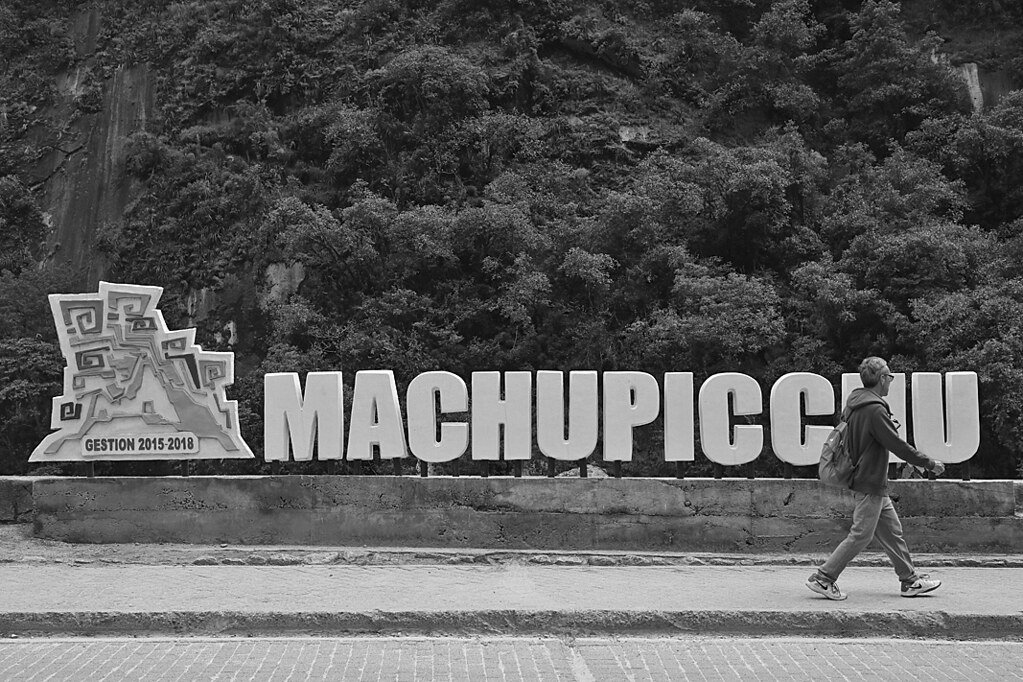 Mijo and I have been planning our trip to Peru for years and it was worth the wait.
Mijo and I have been planning our trip to Peru for years and it was worth the wait. From its modern sites to its Inca ruins, from its ceviche to its Pisco, Mijo and I absolutely enjoyed our Peruvian journey.
Mijo and I had done research many years ago about Peru and I kept some notes from that research. The places we wanted to see in Peru are quite far from each other so the recommendation I wrote down was that we needed to fly from one city to another to save time. And that means we'd need to arrange flights and hotels and airport to hotel transfers. And then there are the ruins and Machu Picchu. We felt like in order to truly get something out of visiting these ruins, we need to get a guided tour. The amount of planning and coordination was overwhelming.
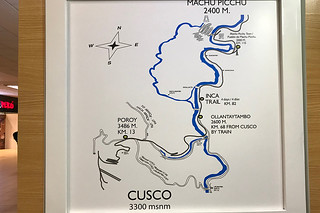
And then I saw that Gate1 Travel has trips to Peru. We've traveled with Gate1 before and we absolutely liked their service and I wouldn't mind traveling with them again. To make the story short - we went with Gate1 to travel to Peru.
Our flight stopped in Panama City but we didn't have enough time to step out of the airport. Luckily, Tocumen International Airport has enough sites and stores that kept us entertained while we were there. The airport is busy since this is Copa Air's hub so everyone coming to and leaving from Latin America converges here.
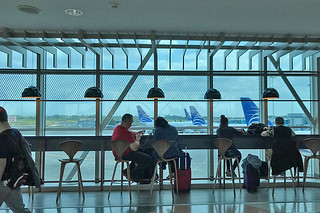
It was late at night when we arrived Lima so we couldn't really do anything that day. We met the tour company's lead guide, Rogger, and he made us feel comfortable and we felt like we are in good hands. Later during the trip, our group would coin #roggersfamily because he called and treated us like family.
The following morning, we stepped out of the hotel early to checkout the scene in the Miraflores district of Lima. Since it was early, there wasn't a lot going on. A few coffee shops were open and locals going about their business.

And then I saw that Gate1 Travel has trips to Peru. We've traveled with Gate1 before and we absolutely liked their service and I wouldn't mind traveling with them again. To make the story short - we went with Gate1 to travel to Peru.
Our flight stopped in Panama City but we didn't have enough time to step out of the airport. Luckily, Tocumen International Airport has enough sites and stores that kept us entertained while we were there. The airport is busy since this is Copa Air's hub so everyone coming to and leaving from Latin America converges here.

It was late at night when we arrived Lima so we couldn't really do anything that day. We met the tour company's lead guide, Rogger, and he made us feel comfortable and we felt like we are in good hands. Later during the trip, our group would coin #roggersfamily because he called and treated us like family.
The following morning, we stepped out of the hotel early to checkout the scene in the Miraflores district of Lima. Since it was early, there wasn't a lot going on. A few coffee shops were open and locals going about their business.
We walked around the block to get a feel of the area. Kennedy Park and the surrounding area seem vibrant and hip. I made a mental note of a couple of places to check out the next time we get a free time from touring. We had to get back to the hotel because our Lima city tour was going to start early.
The great thing about being in a tour group is that we didn't have to arrange anything because they do it for you. We didn't have to plan our day and we don't lose time because of not ever getting lost or waiting for a cab, bus or a train. We get shuttled from one place to another.
Our first stop in the city tour is Lima's Plaza de Armas. I noticed that Plaza Mayors or Plaza de Armas are the center of Latin American cities that I've been to and they all follow the same recipe - a part in the middle, government buildings around it and a cathedral. The picture below is the Government Palace building.
Our first stop in the city tour is Lima's Plaza de Armas. I noticed that Plaza Mayors or Plaza de Armas are the center of Latin American cities that I've been to and they all follow the same recipe - a part in the middle, government buildings around it and a cathedral. The picture below is the Government Palace building.
The plaza is the center of town and in the middle is a huge fountain. The plaza is clean and well kept even though tons of birds hover around the plaza. I imagine this place is where locals come and hangout in the afternoon. I wanted to checkout the cathedral but there was a mass going on and they were not letting tourists go inside and take pictures but I totally understand.
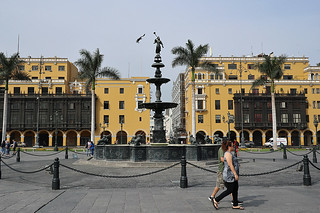
Afterwards, we walked to Basilica y Convento de San Francisco de Lima. The church is huge and the interior has a very beautiful tile work. There is a museum and catacombs adjacent to the church which we did see. Unfortunately, taking pictures is not allowed so I don't have anything to show here.
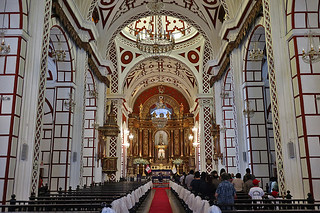
The catacombs is a good way to learn about the city and the church's history. Lots of bones in the catacombs. When I say lots, I mean a lot. I'm just saying. Ha! If you're not fond of bones, you'd probably want to skip the tour of the catacombs. And if you do decide to go, make sure to watch your head while you are down there. Our tour guide, Julia, was very knowledgeable and engaging.

Afterwards, we walked to Basilica y Convento de San Francisco de Lima. The church is huge and the interior has a very beautiful tile work. There is a museum and catacombs adjacent to the church which we did see. Unfortunately, taking pictures is not allowed so I don't have anything to show here.

The catacombs is a good way to learn about the city and the church's history. Lots of bones in the catacombs. When I say lots, I mean a lot. I'm just saying. Ha! If you're not fond of bones, you'd probably want to skip the tour of the catacombs. And if you do decide to go, make sure to watch your head while you are down there. Our tour guide, Julia, was very knowledgeable and engaging.
We had some free time after the tour so Mijo and I decided to have a late lunch at La Mar Cevicheria. There was a long line to the restaurant and this gave us an impression that this place is the place to eat ceviche. We started with their delicious and tasty empanada. We downed the empanadas with Pisco Volador which is pisco with passion fruit. Mijo ordered Pisco Metropolitano which is pisco with lychee. Both were very good and refreshing.
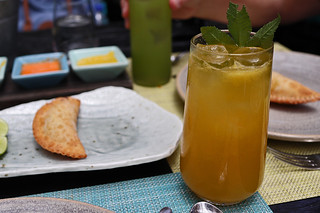
We decided to get their Piqueo Popular which is a combination of
ceviche, paella, and fried seafood called jalea. The portion is huge. The food was heavenly! I was glad we decided to include a visit to La Mar during our free time.

We decided to get their Piqueo Popular which is a combination of
ceviche, paella, and fried seafood called jalea. The portion is huge. The food was heavenly! I was glad we decided to include a visit to La Mar during our free time.
From La Mar, we decided to take Uber and went to Larcomar Mall by the ocean. The views are amazing. The mall sits on the edge the city by the cliffs with a great view of the Pacific Ocean.
This area of the city is modern and hip which is a great contrast to the places we went to in the city tour. I found more places to eat and drink and made a mental note for the next time we are in the area.
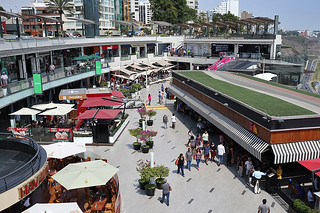

We found a place to sit and have coffee called Juan Valdez Cafe. Good coffee!
We had another hour to rest and relax before our Night tour and dinner at Larco Museum. From my research, there are other museums in the city showcasing archeological relics from ruins dotting the country. However, I was told by our guide Julia, that the Larco Museum is the best one to see. She was right. The collection in this museum was huge and it drowned me. There were no other people in the museum in the evening except us. A private tour of the museum? That made me feel extra special.
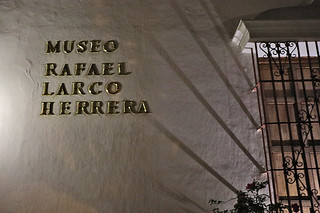
My favorites here are the head dresses made of gold and silver; the quipu, which is a system of knotted cords which the Inca empire used to record countable information; and the Inca pottery.
We were also treated to a nice dinner after our tour. We had a 3 course dinner. This was going to be my first time to try a passion fruit (maracuya in Peru) cheesecake. It was out of this world good!
Our hotel was next to a a vibrant and hip park called Kennedy Park. We had time to stroll around the park on our last day in Peru. Hip restaurants and fashionable cafes surround the park. The park is also home to a big population of cats. Different kinds of cats live in the park.
Other than restaurants and cafes, there are also hip stores around the park. One of these stores is called Choco Museo. I saw this at Plaza De Armas during our city tour of Lima. But there was no time to check it out that day. So I was glad to see this place at Kennedy Park. At first I was sort of confused if the place is a museum or a store. I later found out that it is a store with lots of information about chocolates - history, agriculture, production and other facts.
Another place with good ceviche and good Pisco based drinks is Cafe dela Paz which is also near Kennedy Park.
Our next destination was the Sacred Valley. We flew to Cusco and then a tourist bus whisked us from the airport to a weaving demonstration in a village outside of Cusco and somewhere in the Sacred Valley. The place is like a compound consisting of smaller houses built around a center courtyard.
We were welcomed with traditional Peruvian music. Though we weren't told whether there are different styles of traditional music depending where in Peru the music is from. This is also where we ate traditional Cusco lunch of soup, quinoa, potatoes, sweet yams, beans and small slices of cuy. Cuy is a grilled guinea pig which is a delicacy in this part of Peru. After the delicious lunch, we were given a weaving demonstration using yarns made from alpaca fleece. They start from rinsing the fleece with soap made from grated yucca and natural colors found in soil and rocks and plants pigments. I was impressed with the sustainability of their ways.



Our next destination was a visit to the archeological sites of Chinchero. Since this was our very first day in this altitude, with elevation of over 12,000 feet, we were gasping for air. I noticed I got tired easily. Just going up the bus made me tired.
From the bus stop, the village of Chinchero is on an uphill. Having lived in San Francisco for many years should have given me an advantage and made this hike easy. What happened was quite the opposite. I found myself stopping and gasping for air after every ten steps. There were times I was light headed and felt I was about to pass out. This was going to be my normal hiking/walking pattern for the rest of the our stay around Cusco and the Urubamba province.
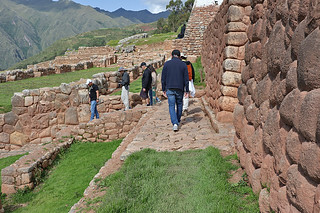
After that trek, we drove to the hotel to check-in and freshen up. But before that, we passed by this absolutely breathtaking view of the Sacred Valley. We were told our hotel is somewhere down there.
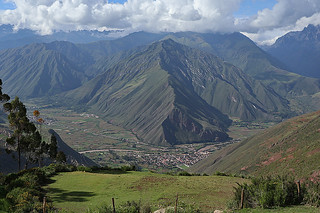
We stayed at the Aranwa Hotel and Wellness and made it our base while we were in the Sacred Valley. We had the rest of the afternoon off so I had time to walk around the hotel premises while everyone in our tour group took a nap. The hotel is very tranquil and the location is picturesque. It is nestled in the valley with the cloud covered mountains surrounding it. One word. Dreamy.
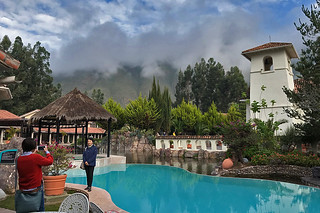
The hotel has it's own movie theatre, art museum, a chapel, a spa, a bar and a pair of alpaca for photo ops. I passed by the movie theatre a couple of times and both times I served myself a small bag of freshly popped popcorn. There was someone in our tour group who skipped a group dinner to try the hotel's spa and she said the massage was superb and truly relaxing. In the hotel's lobby showcases large wall paintings worthy of a wall space at a museum.



The following day, we were driven to the ancient Inca salt ponds of Maras. It is a series of terraced ponds that save the salty water coming out of the mountain. We were asked to try the water streaming out of the mountain by dipping a finger into the running water and tasting the water.
It was still the rainy season when we went to Peru so the salt ponds are a little watered down. Here's what the salt ponds look like during the summer when the salts are more concentrated because of less water.
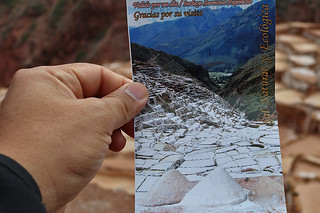
Here's a sample of salt rock produced from the salt ponds. We were told that the salts produced from these ponds are second most nutrient filled salts in the world next to the Himalayan pink salts.
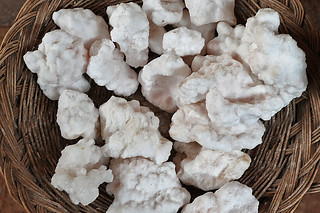
We were whisked away to another place called Moray where we learned about ancient Inca farming. We were told that the concentric circles that descend took advantage of the landscape and it is a technique that allowed the farming of different crops because the temperature varies as the terrace goes down.

Part of the tour was to hike down to the lowest terrace of the depressions and then hike back up. Remember that we were still in high altitude and we were still huffing and puffing because of altitude sickness. Some of the people in the group decided not to hike down. Some of us paced ourselves and slowly descended. The view from below was equally stunning.

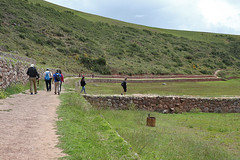
Practicing our hiking skills to see the ancient fortifications in Ollantaytambo.
Being face to face with the awe inspiring Machu Picchu.
Walking around the plaza in Cusco.
Learning about ancient Inca architecture in Qorikancha.
A visit to an ancient site of Saqsaywaman.
Admiring the sceneries during our long trip from Cusco to Puno.
A stop at an ancient pre-Inca site in Raqchi.
Walking around the center of town in Puno.
A visit to the floating islands on Lake Titicaca.
Checking out ancient pre-Inca tombs in Sillustani.
~rl
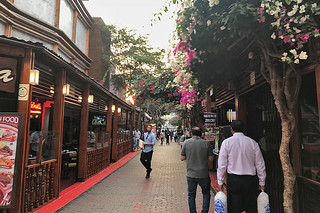


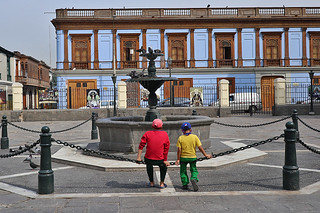

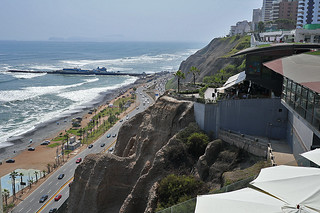
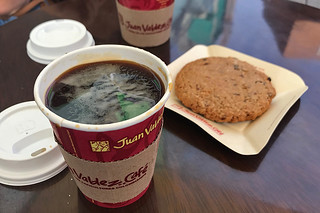



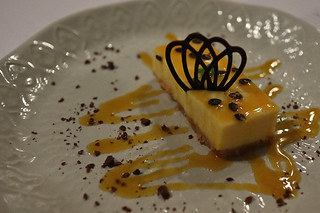

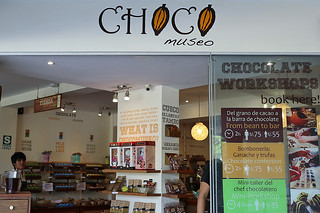
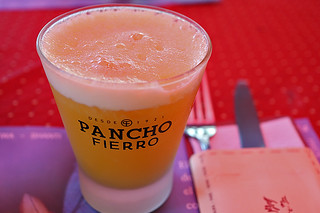
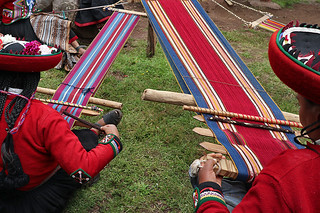
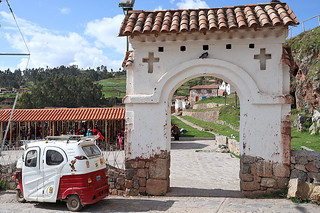
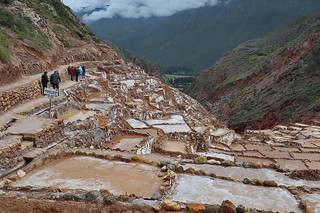
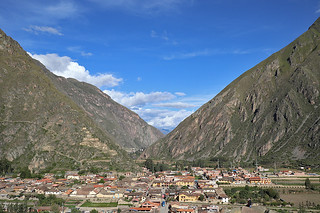
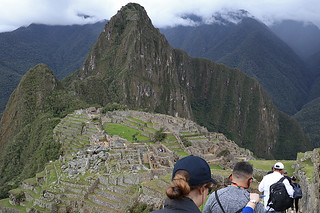
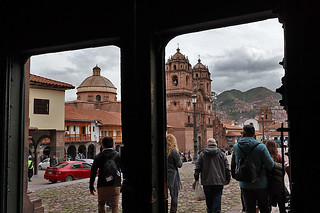
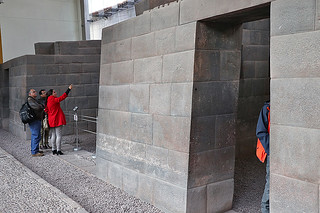
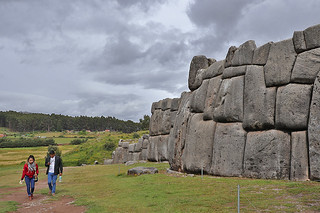
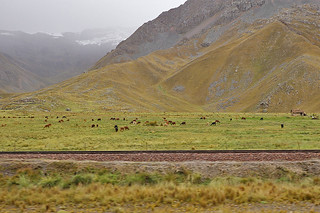

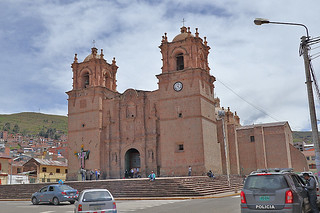
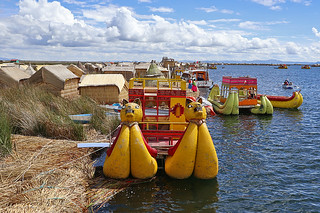
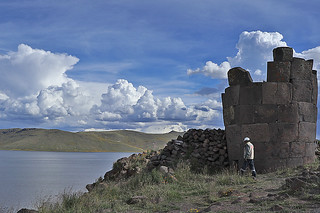
No comments:
Post a Comment